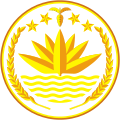Cabinet of Bangladesh
Third Hasina Cabinet | |
|---|---|
19th Council of Ministers of Bangladesh | |
| Incumbent | |
 Hasina | |
| Date formed | 14 January 2014 |
| People and organisations | |
| Head of state | Abdul Hamid |
| Head of government | Sheikh Hasina |
| No. of ministers | 33 Cabinet Ministers 18 State Ministers 2 Deputy Ministers. |
| Total no. of members | 53 |
| Member party | Awami League |
| Status in legislature | 98-seat single-party majority 273 / 350 |
| Opposition party | Jatiya Party |
| Opposition leader | Rowshan Ershad |
| History | |
| Legislature term | 10th Parliament |
| Predecessor | Hasian II |
| This article is part of a series on the |
| Politics of Bangladesh |
|---|
 |
|
|
|
|
The Cabinet of Bangladesh (Template:Lang-bn – Bānglādēśēr Mantri'sabhā) or Council of Ministers (Template:Lang-bn – Bānglādēśēr Mantri'pariṣad) is the chief executive body of the People's Republic of Bangladesh. The Cabinet is the collective decision-making body of the entire government under the Office of the Prime Minister, composed of the Prime Minister and some 33 Cabinet Ministers, 18 State Ministers and 2 Deputy Ministers.
Responsibility
Ministers of the government, according to the Constitution of Bangladesh, are selected primarily from the elected members of House of Nation, also known as Jatiya Sangsad. Cabinet Ministers are heads of government departments, mostly with the office of the "Minister of [department, e.g. Defence]". The collective co-ordinating function of the Cabinet is reinforced by the statutory position that all the Ministers jointly hold the same office, and can exercise the same powers.
The Cabinet is the ultimate decision-making body of the executive within the parliamentary system of government in traditional constitutional theory of Bangladesh. This interpretation was originally put across in the work of the Bangladesh constitution in 1972. The political and decision-making authority of the cabinet has been gradually increased over the last few decades, with some claiming its role has been usurped by a "Prime Ministerial" (i.e. more "presidential") government.
The Cabinet is the executive committee of The Prime Minister's Office, a historic body which has legislative, judicial and executive functions, and whose large membership does include member(s) of the Opposition or Coalition. Its decisions are generally implemented either under the existing powers of individual government departments, or by the Cabinet Secretary.
Council of Ministers
The most influential part of the executive of the Bangladesh government are the ministries.[1] A ministry headed by minister or State minister (Independent Charges) shall be responsible for conducting the business of his Ministry/Division in the Parliament unless otherwise directed by the Prime Minister. The Secretary is the administrative head of a ministry or division, assisted by Additional Secretary, Joint Secretary, Deputy Secretary, Senior Assistant Secretary and Assistant Secretary. Few ministries are consisted of more than one divisions.
There are four categories of ministers, in descending order of rank:
- Minister: member of cabinet; leads a ministry
- State Minister (Independent Charges): junior minister not reporting to a cabinet minister; leads a ministry
- State Minister: junior minister reporting to a cabinet minister, usually tasked with a specific responsibility in that ministry
- Deputy Minister: most junior minister reporting to a cabinet minister or Minister of State (Independent Charges).
List of cabinets
| No. | Cabinet | Formation date | Election | Governing party | Governing system |
|---|---|---|---|---|---|
| 1 | Mujib I | 17 April 1971 | None | Bangladesh Awami League | [[Provisional
Government|Provisional]] |
| 2 | Mujib II | 12 January 1972 | 1970 | Bangladesh Awami League | Provisional |
| 3 | Mujib III | 16 March 1973 | 1973 | Bangladesh Awami League | Parliamentary |
| 4 | Mujib IV | 25 January 1975 | None | Bangladesh Krishak Sramik Awami League | One-party state |
| 5 | Mostaq | 15 August 1975 | None | Military Dictatorship | Authoritarianism |
| 6 | Sayem | 6 November 1975 | None | Military dictatorship | Authoritarianism |
| 7 | Zia | 21 April 1977 | None | Military dictatorship | Junta |
| 8 | Sattar | 30 May 1981 | 1981 | Bangladesh Nationalist Party | Presidential |
| 9 | Ershad | 24 March 1982 | None | Military dictatorship | Junta |
| 10 | Shahabuddin | 6 December 1990 | None | Impartial | Interim |
| 11 | Khaleda I | 20 March 1991 | 1991 & Feb 1996 | Bangladesh Nationalist Party | Parliamentary |
| 12 | Habibur | 30 March 1996 | None | Impartial | Caretaker |
| 13 | Hasina I | 23 June 1996 | Jun 1996 | Bangladesh Awami League | Parliamentary |
| 14 | Latif | 15 July 2001 | None | Impartial | Caretaker |
| 15 | Khaleda II | 10 October 2001 | 2001 | Bangladesh Nationalist Party | Parliamentary |
| 16 | Iajuddin | 29 October 2006 | None | Impartial | Caretaker |
| 17 | Fakhruddin | 11 January 2007 | None | Impartial | Caretaker |
| 18 | Hasina II | 6 January 2009 | 2008 | Bangladesh Awami League | Parliamentary |
| 19 | Hasina III | 24 January 2014 | 2014 | Bangladesh Awami League | Parliamentary |
References
- ^ http://www.bangladesh.gov.bd/index.php?option=com_weblinks&task=ministry&Itemid=152
- ^ "Hon'ble Ministers". Retrieved 27 April 2015.
{{cite web}}: Cite has empty unknown parameter:|1=(help) - ^ "Cabinet". Retrieved 27 April 2015.
{{cite web}}: Cite has empty unknown parameter:|1=(help) - ^ http://www.cabinet.gov.bd/site/page/b31ecc34-a004-4528-b787-5b8381741a8c/Hon'ble-Advisers-



